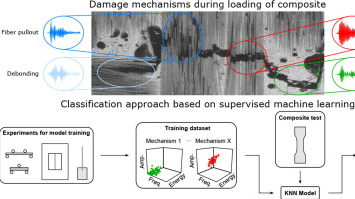Renato S.M. Almeida; Marcelo D. Magalhães; Md Nurul Karim; Kamen Tushtev; Kurosch Rezwan.
Materials and Design, 227 (2023), 111745
doi: 10.1016/j.matdes.2023.111745
Acoustic emission (AE) is a well-established technique for in-situ damage analysis of composite materials. The main challenge, however, is to be able to correlate the measured AE signals with their respective damage mechanism sources. Hence, an innovative approach to classify AE signals based on supervised machine learning is presented in this work. At first, the constituents of a composite (fiber, matrix and interface) are characterized separately and fingerprint information regarding the characteristic AE features of each damage mechanism is gathered. This dataset is then used to train a model based on the k-nearest neighbors algorithm. Model accuracy is calculated to be 88%. Subsequently, AE signals measured during tensile tests of commercial composites are classified by the trained model. The analysis provides important information regarding location, time, frequency and intensity of each damage mechanism. Matrix cracking and fiber debonding are the most frequent damage mechanisms representing around 40% and 20% of the measured AE hits. Nevertheless, fiber breakage is the mechanism that dissipates the most AE energy (40%) for the studied composite. Furthermore, the presented method can also be applied together with other techniques like computer tomography, delivering a powerful approach to understand different multi-phase materials.
© 2023 Attribution 4.0 International (CC BY 4.0)


